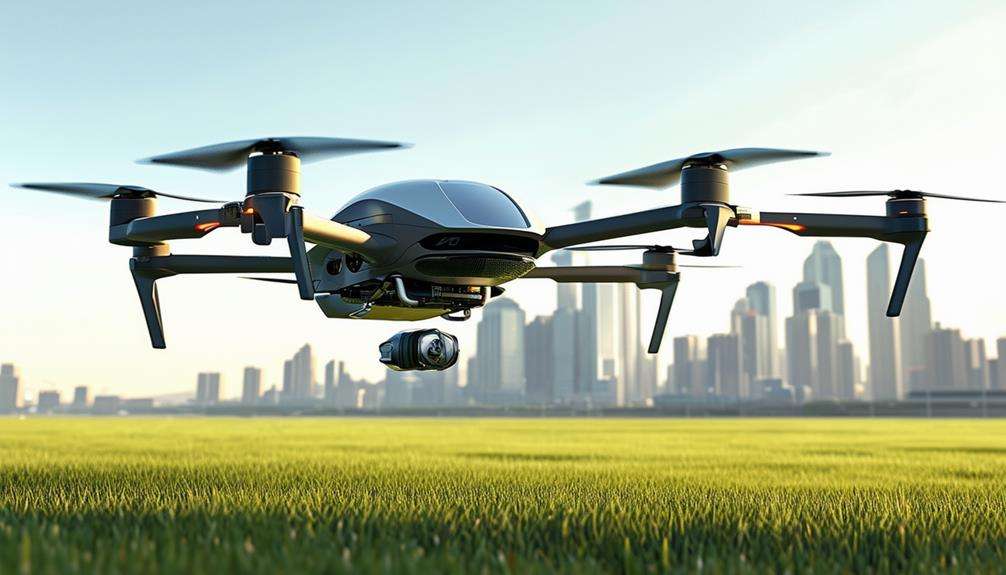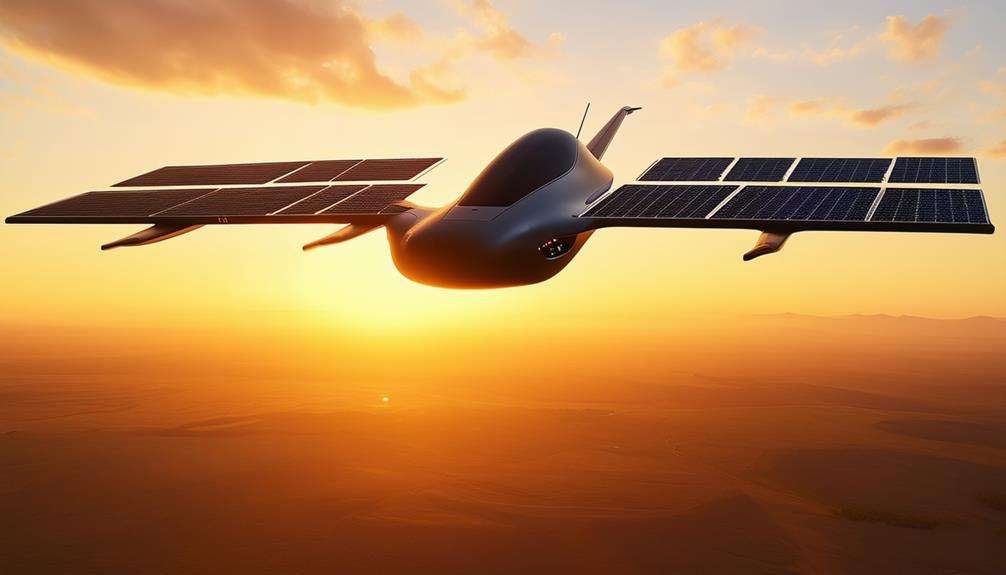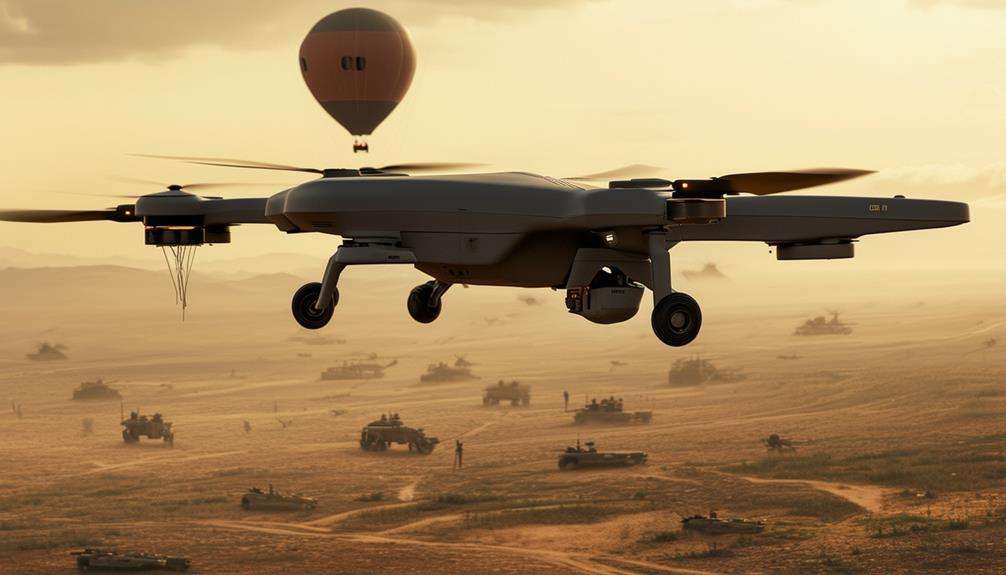Drones in Underwater Exploration: The Next Frontier

Imagine deploying drones to explore the ocean's mysterious depths, uncovering secrets hidden for centuries. These advanced machines could revolutionize marine research through precise data collection and safe navigation in hard-to-reach areas.
Underwater drones promise to enhance our understanding of aquatic ecosystems significantly. However, what challenges do they face, and how do they compare to traditional methods Despite their enormous potential, much remains to be discovered in this exciting frontier.
Advancements in Underwater Drones
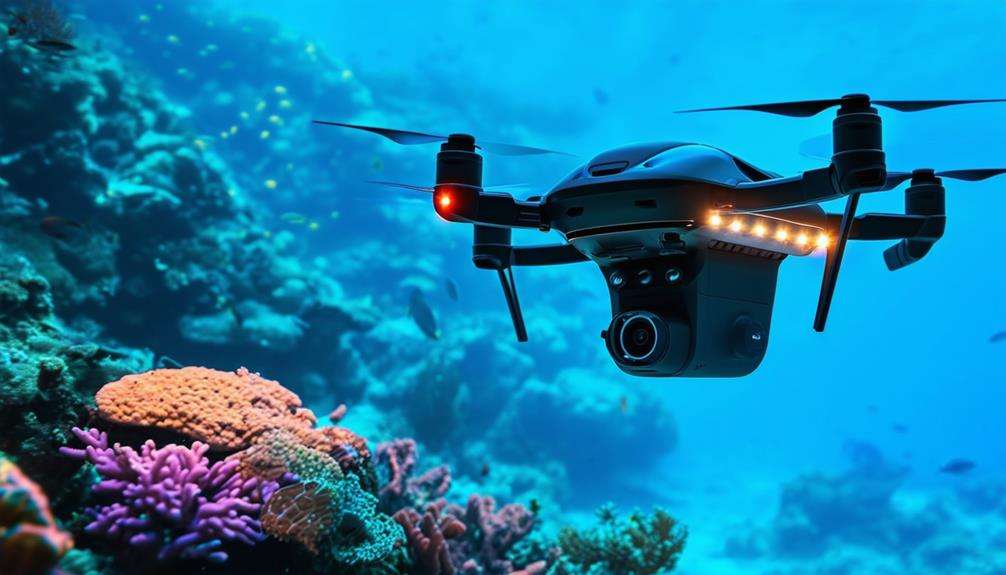
Recent advancements in underwater drones, such as the Gladius Mini, have transformed the exploration of aquatic environments. These innovations allow you to delve into the depths and uncover hidden marine wonders without ever getting wet, all from the comfort of your boat or shore.
The Gladius Mini exemplifies this shift with its cutting-edge design and user-friendly interface. With five thrusters, the drone offers exceptional maneuverability, enabling precise navigation through complex underwater terrains. Whether you're a hobbyist or a professional researcher, the Gladius Mini's capabilities are remarkable.
Utilizing a 165-foot tether, you can control the drone via a wired connection, providing ample range to explore submerged ecosystems. Control options include a mobile app for phones or tablets and a physical remote controller resembling a gaming controller, ensuring an intuitive and enjoyable user experience.
The Gladius Mini captures 4K video footage, ensuring you don't miss any underwater details. Safety features such as depth control, stability, and bright lights for improved visibility make your exploration safer and more efficient. Additionally, the emergency reeling option using the tether adds an extra layer of security, ensuring trustworthiness and reliability in your underwater investigations.
Key Technologies Utilized
When exploring underwater, drones benefit from advanced navigation systems, high-resolution imaging, and autonomous operation capabilities. These technologies ensure precise movement, crystal-clear visuals, and efficient exploration without constant human intervention. Understanding these key components will help you appreciate the full potential of underwater drones.
Advanced Navigation Systems
Advanced navigation systems in underwater drones incorporate cutting-edge technologies to enhance precision and autonomy in complex aquatic environments. These systems leverage advancements from aerial drone technology, where navigation and security challenges have been extensively addressed.
By integrating space-rated fiber optic gyroscopes, such as the Boreas X90 from Advanced Navigation, underwater drones achieve exceptional stability and accuracy. These gyroscopes, initially designed for lunar and Mars missions, enable underwater drones to navigate difficult terrains, map ocean floors, and assist in deep-sea research. This technology ensures that drones maintain their orientation and trajectory even in the most challenging underwater conditions, making them invaluable for:
- Marine conservation efforts: Protecting fragile ecosystems and monitoring endangered species.
- Archaeological discoveries: Uncovering ancient shipwrecks and submerged cities.
- Commercial applications: Conducting precise inspections of underwater infrastructure like pipelines and cables.
- Search and rescue missions: Enhancing the ability to locate and retrieve objects or individuals lost at sea.
Advanced Navigation's innovations highlight Australia's expanding expertise in both underwater and space technology. Their contributions aren't only advancing underwater exploration but also paving the way for a more autonomous and efficient future.
High-Resolution Imaging
High-resolution imaging in underwater exploration relies on state-of-the-art technologies that provide stunning 4K video footage and detailed visual data. Utilizing drones like the Gladius Mini, you can capture breathtaking underwater views with remarkable clarity. These drones are equipped with advanced navigation technologies, such as fiber optic gyroscopes like the Boreus X90, which enhance stability and imaging accuracy.
To ensure high-quality imaging even in the darker depths of the ocean, underwater drones are fitted with powerful lights. This illumination is crucial for maintaining visibility and capturing clear, precise images in challenging conditions. The Gladius Mini also offers impressive stability and depth control features, allowing it to maintain a steady position and produce sharp, detailed images.
High-resolution imaging isn't just for creating beautiful footage; it has practical applications as well. Whether you're conducting marine research or inspecting underwater infrastructure, the detailed visual data provided by these drones is invaluable. The ability to gather high-quality images from the depths supports a wide range of underwater exploration activities, making these technologies indispensable tools for modern explorers.
Autonomous Operation Capabilities
Autonomous operation capabilities in underwater drones are powered by advanced technologies such as AI algorithms, sophisticated sensors, and cutting-edge navigation systems. These innovations enable drones, like the Gladius Mini, to navigate complex underwater environments with minimal human intervention. This makes tasks such as infrastructure inspection, underwater mapping, and marine research significantly safer and more efficient.
These autonomous features free operators from constant manual control, allowing the drone to independently handle a variety of tasks through:
- AI Algorithms: Facilitating real-time decision-making and adaptation to unexpected underwater conditions.
- High-Quality Sensors: Detecting obstacles, measuring distances, and gathering critical data.
- Advanced Navigation Systems: Ensuring accurate course plotting, even in low-visibility conditions.
- Enhanced Safety: Reducing the need for human divers in hazardous environments.
Imagine the excitement of deep-sea exploration, knowing that sophisticated technology is guiding the drone every step of the way. This level of autonomy is revolutionizing underwater exploration, expanding the horizons of what can be achieved.
Applications in Marine Research

Marine researchers employ Gladius Mini underwater drones to explore and understand complex underwater ecosystems in unprecedented ways. These advanced drones enable the assessment of coral reef health, the study of diverse underwater habitats, and the precise monitoring of marine species. The high-quality video footage and data collected by these drones facilitate comprehensive analysis and understanding of underwater environments.
When conducting surveys, Gladius Mini drones allow for accurate mapping of underwater topography, providing detailed insights into the ocean floor's structure. These drones are essential for studying ocean dynamics, enabling the observation and recording of changes in water currents, temperature, and other critical factors over time.
Gladius Mini drones also provide access to remote and hard-to-reach areas, offering unique perspectives on underwater ecosystems. This capability significantly advances marine research by gathering data that would otherwise be challenging or impossible to obtain.
Whether monitoring species populations or investigating the impact of environmental changes, these drones are invaluable tools in the endeavor to understand and protect our oceans.
Benefits Over Traditional Methods
Underwater drones provide numerous advantages over traditional methods. They collect high-quality data, reduce costs, and access areas that are otherwise unreachable. These benefits make underwater drones essential tools for underwater exploration.
Enhanced Data Collection
Underwater drones like the Gladius Mini, equipped with high-quality 4K video capabilities, are transforming data collection by providing unmatched detail and accuracy. Imagine exploring the ocean's depths from the safety of your boat—these drones make it possible, eliminating the risks associated with human diving in hazardous conditions.
Equipped with multiple thrusters, these drones ensure precise navigation and data collection even in the most challenging underwater terrains. This real-time data and imagery significantly enhance your analysis and decision-making processes.
Consider the benefits:
- Safety: Protect human divers by keeping them out of dangerous environments.
- Precision: Navigate complex underwater landscapes with pinpoint accuracy.
- Real-Time Data: Obtain immediate access to crucial data and imagery.
- Environmental Protection: Enhance your ability to monitor and safeguard underwater ecosystems.
The data gathered by underwater drones is invaluable for a range of applications, including infrastructure inspections and scientific research. These advanced tools enable more effective monitoring, assessment, and protection of underwater environments, driving technological and environmental progress.
Cost-Effective Operations
Ever wondered how you can cut costs in underwater exploration without compromising on quality? Underwater drones like the Gladius Mini offer a budget-friendly alternative to traditional methods that often involve divers or expensive underwater vehicles. These drones are revolutionizing underwater tasks by providing a cost-effective solution for exploration, inspection, and monitoring.
The Gladius Mini significantly reduces costs related to equipment and manpower. Traditional methods often necessitate hiring skilled divers and deploying costly underwater vehicles, both of which add up quickly. Underwater drones eliminate these expenses, making them an economical option for various industries.
Here's a quick comparison:
| Traditional Methods | Underwater Drones |
|---|---|
| High equipment costs | Affordable drone units |
| Skilled diver expenses | Minimal operational costs |
| Time-consuming setups | Quick deployment |
| Limited reach | Versatile and scalable |
The efficiency and cost-effectiveness of underwater drones make them a practical choice for businesses aiming to optimize their underwater exploration processes. By opting for drones, you save money while ensuring high-quality results. Whether inspecting underwater infrastructure or exploring marine environments, these drones provide a reliable and cost-effective solution.
Accessibility to Depths
Underwater drones, such as the Gladius Mini, offer unparalleled access to depths that traditional methods can't reach. Capable of investigating up to 100 meters below the surface, these drones open new possibilities for underwater exploration. Unlike traditional diving, which requires costly gear and extensive training, the Gladius Mini is both cost-effective and user-friendly.
Imagine exploring uncharted underwater territories without the physical limitations of human divers. The Gladius Mini can effortlessly navigate tight spaces and hard-to-reach areas, providing a unique advantage. Traditional methods simply can't match the precision and flexibility that underwater drones offer.
Consider these benefits:
- Safety: Minimize the risks associated with sending human divers into deep or hazardous environments.
- Real-Time Investigation: Experience the excitement of real-time footage and data collection, enhancing accuracy and efficiency.
- Accessibility: Break down barriers to underwater exploration, making it possible for anyone with a drone to explore the depths.
- Innovation: Participate in cutting-edge technology that's revolutionizing our understanding of the oceans.
Underwater drones like the Gladius Mini aren't just tools; they're gateways to exploration, offering unparalleled access to the mysteries of the deep.
Challenges and Limitations
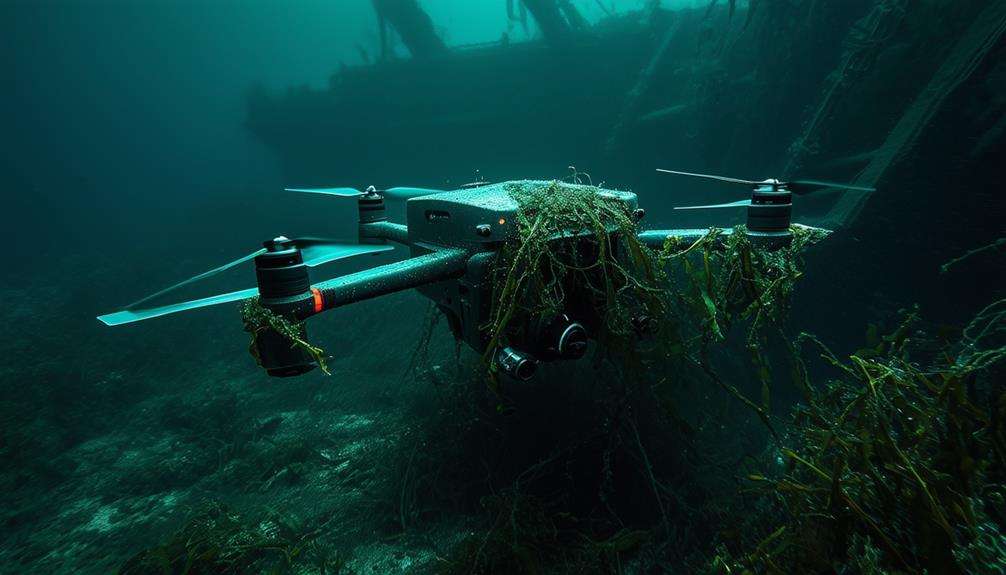
Managing the logistical challenges of separately charging the sub, remote controller, and base station can complicate the use of the Gladius Mini underwater drone. Ensuring all components are fully charged before your underwater exploration requires careful planning and time, especially if you aim to get into the water quickly.
Furthermore, the need for a wired connection introduces another layer of limitation. The tether cord, while essential for control and safety, restricts the drone's range compared to wireless counterparts. This setup necessitates being mindful of the cord's length and potential entanglement hazards, which can limit your operational freedom underwater.
Despite these challenges, the Gladius Mini remains portable and convenient for on-the-go exploration. Its compact design allows for easy transport in a backpack, making it ideal for spontaneous adventures.
However, the requirement for multiple hardware pieces and the limitations of a wired connection might demand additional planning and maneuvering. Balancing these factors is crucial for a successful and enjoyable underwater exploration experience.
Future Prospects
While current challenges in underwater drone technology are evident, future prospects suggest groundbreaking advancements that could revolutionize underwater exploration.
Imagine drones navigating the ocean's depths with the same precision as spacecraft maneuvering through space. The Moon to Mars Initiative in Australia, supported by the Australian Space Agency, is already developing navigation technology that can be adapted for underwater drones. Companies like Advanced Navigation are at the forefront of creating autonomy technology initially intended for space missions.
These technological breakthroughs could soon be applied to underwater exploration, offering:
- Enhanced Navigation: Utilizing space-rated technology, such as the Boreus X90 fiber optic gyroscope, for precise underwater guidance.
- Autonomous Operations: Drones capable of autonomous decision-making in complex underwater environments.
- Inspiration for Future Generations: Just as space exploration inspires, these advancements can engage young minds in marine science.
- Transforming Science Fiction into Reality: Technologies once thought to exist only in science fiction can become tangible tools for underwater research.
These prospects promise not only technological advancements but also the inspiration of a new generation of researchers.
Conclusion
Underwater drones are transforming marine research with their cutting-edge technology and capabilities. They provide significant advantages over traditional methods, offering safer, more cost-effective, and precise data collection.
Despite certain challenges and limitations, the future outlook is highly promising. With ongoing innovation, underwater drones are poised to play a crucial role in protecting our oceans and deepening our understanding of aquatic ecosystems for generations to come. Dive into this exciting frontier!


